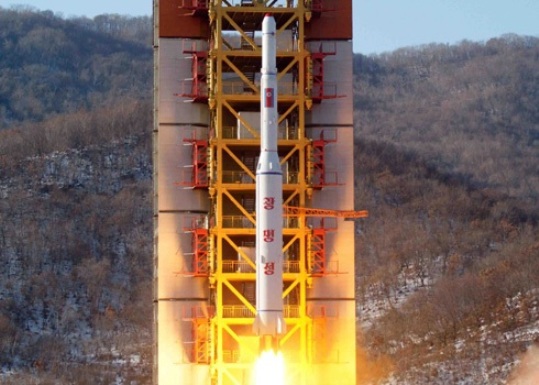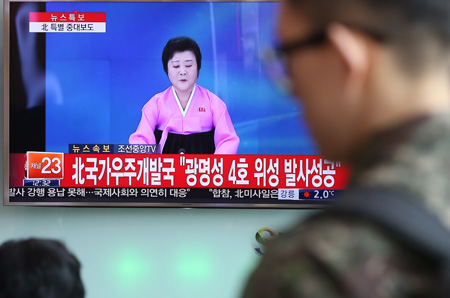- California Assembly OKs highest minimum wage in nation
- S. Korea unveils first graphic cigarette warnings
- US joins with South Korea, Japan in bid to deter North Korea
- LPGA golfer Chun In-gee finally back in action
- S. Korea won’t be top seed in final World Cup qualification round
- US men’s soccer misses 2nd straight Olympics
- US back on track in qualifying with 4-0 win over Guatemala
- High-intensity workout injuries spawn cottage industry
- CDC expands range of Zika mosquitoes into parts of Northeast
- Who knew? ‘The Walking Dead’ is helping families connect
N. Korea fires long-range rocket
North claims satellite enters orbit; South also indicates launch was successful

A North Korean long-range rocket is launched into the air at the Sohae rocket launch site, North Korea, Feb. 7, 2016. ( Yonhap)
By Yi Whan-woo, Jun Ji-hye
North Korea launched a long-range rocket in what seems to be an intercontinental ballistic missile (ICBM), Sunday, despite the international community’s continuous warnings.
The defiant move of the communist state came about a month after it carried out the fourth nuclear test on Jan. 6, raising further military tension in the Korean Peninsula as well as in the international society.
“North Korea fired a long-range missile at 9:30 a.m. from its launch site in Dongchang-ri,” the Joint Chiefs of Staff (JCS) said in a statement.
The isolated state later announced that it succeeded in putting the newly developed earth observation satellite “Kwangmyongsong-4″ into its orbit. The JCS also said the North’s launch seemed to be successful.
The launch came during a five-day Lunar New Year holiday, or “Seollal,” here, which stretched out from Saturday to Wednesday.

A North Korean long-range rocket is launched into the air at the Sohae rocket launch site, North Korea, Feb. 7, 2016. ( Yonhap)
The North is suspected of having used the launch of a satellite as a cover for the test-firing of the ICBM with a range of some 10,000 kilometers, given that the technologies for both are almost identical. The U.S.-led allies view the launch as a part of the program to develop a nuclear-tipped ICBM, ultimately aimed at striking the U.S. mainland.
The South Korean military’s Aegis destroyer, the ground-based Green Pine radar and the early warning and control aircraft Peace Eye detected the North’s launch of the long-range rocket almost simultaneously at 9:31 a.m. The missile disappeared from the South’s surveillance radar at 9:36 a.m. when its fairing was separated southwest of Jeju Island.
“The North’ missile fired this time can be seen as the ICBM similar to one launched in December 2012, with a range of more than 5,500 kilometers and up to 10,000 kilometers,” a JCS official was quoted as saying by Rep. Yoon Hu-duk of the main opposition Minjoo Party of Korea.
Pyongyang has claimed that the purpose of the launch is to send its Earth observation satellite into the orbit, arguing that the peaceful use of space is the sovereign right of any nation.
Pyongyang’s state-run media, the Korea Central News Agency (KCNA), reported that North Korean leader Kim Jong-un issued an autograph order on launching the satellite, Saturday.
At 12:30 p.m., the Kim Jong-un regime made a “special announcement,” during which it claimed that the satellite entered its preset orbit in 9 minutes 46 seconds after the launch.
“The satellite is going round the polar orbit at 494.6-kilometer perigee altitude and 500-kilometer apogee altitude at the angle of inclination of 97.4 degrees. Its cycle is 94 minutes and 24 seconds,” the KCNA said. “Installed in Kwangmyongsong-4 are measuring apparatuses and telecommunications apparatuses needed for observing the earth.”
It added that the success of the launch is the “proud fruition of the great Workers’ Party of Korea’s policy” to develop the North’s science, technology, economy and defense capability by “legitimately exercising the right to use space for independent and peaceful purposes.”
An official at the Ministry of National Defense told reporters on the condition of anonymity, “It is assumed that the North’s projectile has entered into orbit,” indicating that Pyongyang’s test-firing of the ICBM was successful. The official made the remark after Seoul and Washington conducted the preliminary analysis of the launch.
President Park Geun-hye condemned North Korea for making “intolerable provocations.”
“Such provocative acts bring challenge on international community because it came at a time when U.N. Security Council (UNSC) has been discussing possible measures to punish North Korea for its latest nuclear test,” Park said during a National Security Council (NSC) meeting at Cheong Wa Dae.
“The UNSC should come up with strong sanctions against Pyongyang. South Korea will also take all possible measures in its alliance with the U.S. to better counter North Korea’s military attacks.”
Foreign Minister Yun Byung-se said, “All countries including China need to join hands to take countermeasures against the North.”
He talked with his U.S. counterpart John Kerry and Japanese counterpart Fumio Kishida an on joint countermeasures to the North’s launch.
South Korea, the U.S. and Japan, three members of the six-party talks on Pyongyang’s nuclear program, requested the U.N. Security Council to convene an emergency meeting.
Hwang Joon-kook, Seoul’s top nuclear envoy, and his U.S. counterpart Sung Kim had a telephone conversation to discuss issues on Pyongyang’s rocket launch.
The government additionally reduced the number of South Koreans staying at the South-North joint industrial complex at the North Korean city of Gaeseong to 500, out of concerns that heightened tensions between the two Koreas could threaten their safety.
The government began restricting entry of its nationals into the complex in the wake of the North’s nuclear test. Since the measure, some 600 South Koreans were staying at the complex.
In line with international regulations, Pyongyang initially notified the International Maritime Organization (IMO), a U.N. body, that the rocket would be fired between Feb. 8 and 25.
On Saturday, it then advanced the launch window to Feb. 7-14, and launched on Sunday, in what many see as a move determined by the clear weather.
But some media reports also raised speculation that Kim Jong-un, who is a sports fanatic, wanted to draw attention from the U.S. ahead of the 2016 Super Bowl 50. It will take place at Santa Clara, Calif., Monday (KST).
The prediction in South Korea was that the North was possible of further provocations, in the days and months leading up to its Workers’ Party congress in May. In a close-door session before lawmakers, the National Intelligence Service said that North Korea has technology for intercontinental ballistic missiles and that the country is preparing for a fifth nuclear test, according to news reports.
















